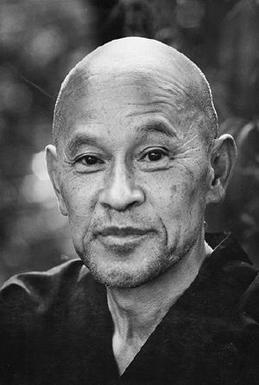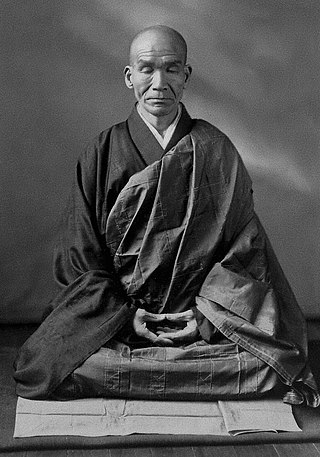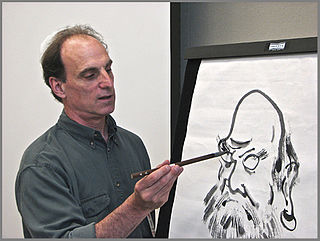
Dōgen Zenji, also known as Dōgen Kigen (道元希玄), Eihei Dōgen (永平道元), Kōso Jōyō Daishi (高祖承陽大師), or Busshō Dentō Kokushi (仏性伝東国師), was a Japanese Buddhist priest, writer, poet, philosopher, and founder of the Sōtō school of Zen in Japan.

Sōtō Zen or the Sōtō school is the largest of the three traditional sects of Zen in Japanese Buddhism. It is the Japanese line of the Chinese Cáodòng school, which was founded during the Tang dynasty by Dòngshān Liánjiè. It emphasizes Shikantaza, meditation with no objects, anchors, or content. The meditator strives to be aware of the stream of thoughts, allowing them to arise and pass away without interference.

Shunryu Suzuki was a Sōtō Zen monk and teacher who helped popularize Zen Buddhism in the United States, and is renowned for founding the first Zen Buddhist monastery outside Asia. Suzuki founded San Francisco Zen Center which, along with its affiliate temples, comprises one of the most influential Zen organizations in the United States. A book of his teachings, Zen Mind, Beginner's Mind, is one of the most popular books on Zen and Buddhism in the West.

Taisen Deshimaru was a Japanese Sōtō Zen Buddhist teacher, who founded the Association Zen Internationale.

Kodo Sawaki was a prominent Japanese Sōtō Zen teacher of the 20th century. He is considered to be one of the most significant Zen priests of his time for bringing Zen practice into the lives of laypeople and popularizing the ancient tradition of sewing the kesa. Peter Sloterdijk has called him "one of the most striking Zen masters of recent times."

Daiun Sogaku Harada was a Sōtō Zen monk who trained under both Sōtō and Rinzai teachers and became known for his teaching combining methods from both schools.

Shōhaku Okumura is a Japanese Sōtō Zen priest and the founder and abbot of the Sanshin Zen Community located in Bloomington, Indiana, where he and his family currently live. From 1997 until 2010, Okumura also served as director of the Sōtō Zen Buddhism International Center in San Francisco, California, which is an administrative office of the Sōtō school of Japan.
Kosho Uchiyama was a Sōtō priest, origami master, and abbot of Antai-ji near Kyoto, Japan.
Isshō Fujita was born in Niihama, Ehime, Japan and was head teacher at Valley Zendo, a Sōtō Zen practice center in Charlemont, Massachusetts, USA. Fujita had done studies in child psychology at Tokyo University Graduate School, but abandoned them and became a Zen monk. At the age of twenty-nine, on 8 December, Fujita was ordained a Zen priest, along with Ryōdō Yamashita, by Kōhō Watanabe at Antai-ji temple.

Sanshin Zen Community is a Soto Zen sangha based at the temple Sanshin-ji in Bloomington, Indiana founded by Shohaku Okumura.
Arthur Braverman is an American author and translator, primarily translating from Japanese to English. A Zen Buddhist practitioner, Braverman lived in Japan for seven years and studied at Antai-ji temple in 1969 training under Kosho Uchiyama. In 1978 he returned to the United States and studied classical Japanese at Columbia University. He lives in Ojai, CA with his wife.

Muhō Nölke (ネルケ無方) is a German-born Zen monk who was the abbot of Antai-ji, a Japanese Sōtō Zen temple in Shin'onsen in the Mikata District of Japan's Hyōgo Prefecture from 2002 until 2020. He has translated works of Dōgen and Kōdō Sawaki, and has authored five books in German and sixteen books in Japanese.

Keidō Fukushima was a Japanese Rinzai Zen master, head abbot of Tōfuku-ji, centered in Kyoto, Japan. Because of openness to teaching Western students, he had considerable influence on the development of Rinzai Zen practice in the West.
Bendōwa (辨道話), meaning Discourse on the Practice of the Way or Dialogue on the Way of Commitment, sometimes also translated as Negotiating the Way, On the Endeavor of the Way, or A Talk about Pursuing the Truth, is an influential essay written by Dōgen, the founder of Zen Buddhism's Sōtō school in Japan.
Zen institutions have an elaborate system of ranks and hierarchy, which determine one's position in the institution. Within this system, novices train to become a Zen priest, or a trainer of new novices.
Sodō Yokoyama was a Japanese Sōtō Zen teacher of the 20th century. Also known as the Leaf Flute Zen Master, he was famous for residing in a public park in Komoro in Nagano Prefecture where he practiced zazen and played songs for travelers by whistling on a leaf. He had resided at Antai-ji for eight years from 1949 to 1957 as a student of Kodo Sawaki before moving to Komoro in 1959. He continued his life in the park until his death in 1980.
Gyobutsuji Zen Monastery is a small Sōtō Zen Buddhist monastery near Kingston in Madison County, Arkansas in the United States. It is located in the Boston Mountains of the Ozarks. The temple focuses primarily on the practice of zazen in the tradition of Kosho Uchiyama and Shohaku Okumura, the latter being the teacher of the founder, Shōryū Bradley. Study of the writings of Eihei Dōgen and the teachings of Shakyamuni Buddha are also emphasized. The monastery holds a five-day sesshin every month except in January and August.

Michael Hofmann is an artist and teacher. He has been an active sumi-e painter since moving from the United States to Japan in 1972. For 33 years Hofmann worked closely with Jikihara Gyokusei (1904-2005), the prominent sumi-e painter, Abbot of Kokusei-ji Temple, Awajishima and Director of Japan's National Association of Nanga Painters. Hofmann has taught sumi-e ink painting at universities, museums and cultural institutions in both Japan and the United States. He has illustrated numerous books and his work has been exhibited extensively in galleries and museums.

Bokusan Nishiari, was a prominent Japanese Sōtō Zen Buddhist monk during the Meiji Era. He is considered one of the most influential Sōtō priests of the modern era due to his elevation of the status of the school's founder Eihei Dōgen, the many prominent positions he held during his lifetime, and his almost equally prolific disciples Sōtan Oka and Ian Kishizawa. Nishiari's positions included abbot of Sōtō's head temple Sōji-ji, professor at what would become Komazawa University, and chief priest, or kanchō, of the entire Sōtō school. His student Sōtan Oka was the first abbot of Antai-ji and a teacher to both Kōdō Sawaki and Hashimoto Ekō, each of whom are the source of Zen lineages in the United States. His student Ian Kishizawa taught Shunryū Suzuki, the founder of the San Francisco Zen Center. Though critical of Nishiari later in his life, the founder of the Sanbō Kyōdan sect Hakuun Yasutani also studied extensively with him and Kishizawa. The Buddhist studies scholar William Bodiford writes of Nishiari:
Today, when someone remembers Dōgen or thinks of Sōtō Zen, most often that person automatically thinks of Dōgen's Shōbōgenzō. This kind of automatic association of Dōgen with this work is very much a modern development. By the end of the fifteenth century most of Dōgen's writings had been hidden from view in temple vaults where they became secret treasures ... In earlier generations only one Zen teacher, Nishiari Bokusan (1821–1910), is known to have ever lectured on how the Shōbōgenzō should be read and understood.

Shūhō Myōchō, aka Daitō Kokushi, was a Japanese Zen master of the Rinzai school. He was the second patriarch of the Ōtōkan-lineage, and founder and first abbot of the Daitoku-ji (大德寺) in Kyōto, one of Japan's most important temples.














